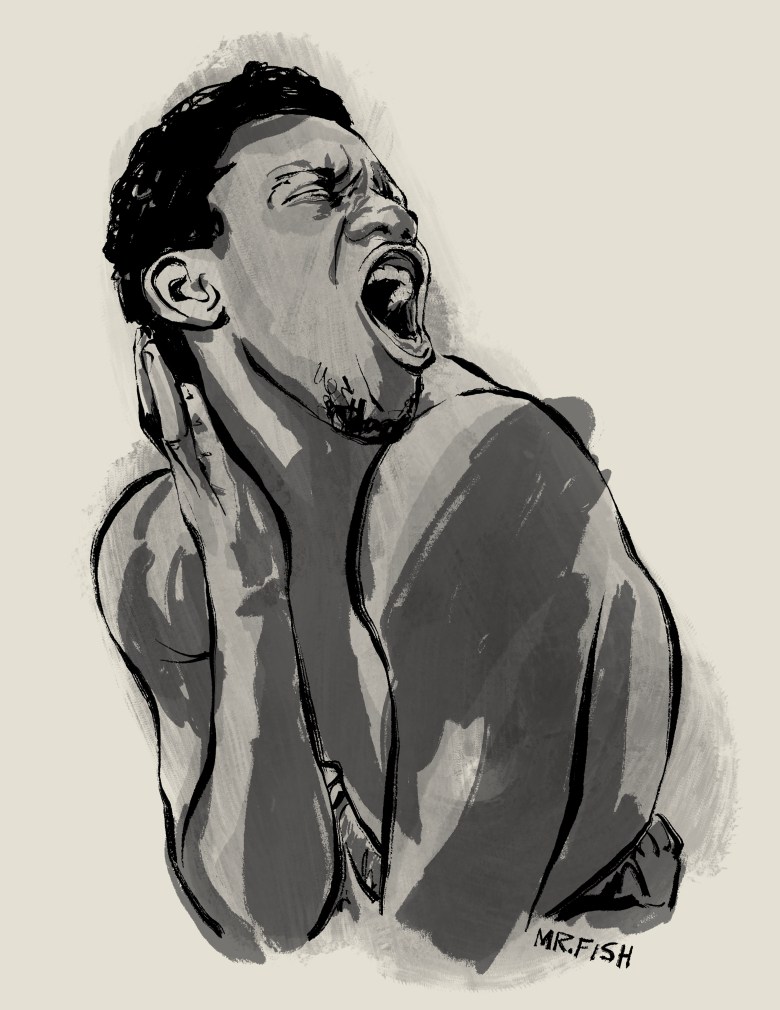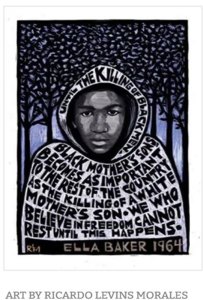The powerful keep those they exploit from knowing who they are, where they came from and the crimes of the ruling class. As social inequality mounts, so does the campaign to keep us in darkness.

Chris Hedges: They Crush Our Song for a Reason
By Chris Hedges /Original to ScheerPost
August Wilson wrote 10 plays chronicling Black life in the 20th century. His favorite, Joe Turner’s Come and Gone, is set in 1911 in a boarding house in Pittsburgh’s Hill District. The play’s title comes from “Joe Turner’s Blues,” written in 1915 by W. C. Handy. That song refers to a man named Joe Turney, the brother of Peter Turney, who was the governor of Tennessee from 1893 to 1897. Joe Turney transported Black prisoners, chained in a coffle, along the roads from Memphis to the Tennessee State Penitentiary in Nashville. While en route, he handed over some of the convicts, for a commission, to white farmers. The prisoners he leased to the farmers worked for years in a system of convict leasing — slavery by another name.
In Wilson’s play, Herald Loomis, a convict who worked on Turner’s farm, arrives in Pittsburgh after seven years of bondage with his 11-year-old daughter, Zonia, in search of his wife. He struggles to cope with his trauma. At a boarding house, he meets a conjurer named Bynum Walker, who tells him that, to face and overcome the demons that torment him, he must find his song.
It is your song, your voice, your history, Walker tells him, which gives you your identity and your freedom. And your song, Walker tells him, is what the white ruling class seeks to eradicate.
This denial of one’s song is instrumental to bondage. Black illiteracy was essential to white domination of the South. It was a criminal offense to teach enslaved people to read and write.
The poor, especially poor people of color , remain rigidly segregated within educational systems. The backlash against critical race theory (CRT), explorations of LGBTQ+ identities and the banning of books by historians such as Howard Zinn and writers such as Toni Morrison, are extensions of this attempt to deny the oppressed their song.
PEN America reports that proposed educational gag orders have increased 250 percent compared with those issued in 2021. Teachers and professors who violate these gag orders can be subject to fines, loss of state funding for their institutions, termination and even criminal charges. Ellen Schrecker, the leading historian of the McCarthy era’s widespread purging of the U.S. education system, calls these gag bills “worse than McCarthyism.” Schrecker, who authored No Ivory Tower: McCarthyism and the Universities, Many Are the Crimes: McCarthyism in America and The Lost Promise: American Universities in the 1960s, writes:
The current campaign to limit what can be taught in high school and college classrooms is clearly designed to divert angry voters from the deeper structural problems that cloud their own personal futures. Yet it is also a new chapter in the decades-long campaign to roll back the changes that have brought the real world into those classrooms. In one state after another, reactionary and opportunistic politicians are joining that broader campaign to overturn the 1960s’ democratization of American life. By attacking the CRT bogeyman and demonizing contemporary academic culture and the critical perspectives that it can produce, the current limitations on what can be taught endanger teachers at every level, while the know-nothingism these measures encourage endangers us all.
The more social inequality grows, the more the ruling class seeks to keep the bulk of the population within the narrow confines of the American myth: the fantasy that we live in a democratic meritocracy and are a beacon of liberty and enlightenment to the rest of the world. Their goal is to keep the underclass illiterate, or barely literate, and feed them the junk food of mass culture and the virtues of white supremacy, including the deification of the white male slaveholders who founded this country.
When books that give a voice to oppressed groups are banned, it adds to the sense of shame and unworthiness the dominant culture seeks to impart, especially toward marginalized children. At the same time, bans mask the crimes carried out by the ruling class. The ruling class does not want us to know who we are. It does not want us to know of the struggles carried out by those who came before us, struggles that saw many people blacklisted, incarcerated, injured and killed to open democratic space and achieve basic civil liberties from the right to vote to union organizing. They know that the less we know about what has been done to us, the more malleable we become. If we are kept ignorant of what is happening beyond the narrow confines of our communities and trapped in an eternal present, if we lack access to our own history, let alone that of other societies and cultures, we are less able to critique and understand our own society and culture.
W.E.B. Du Bois argued that white society feared educated Blacks far more than they feared Black criminals.
“They can deal with crime by chain-gang and lynch law, or at least they think they can, but the South can conceive neither machinery nor place for the educated, self-reliant, self-assertive black man,” he wrote.
Those, like Du Bois, who was blacklisted and driven into exile, who pull the veil from our eyes are especially targeted by the state. Rosa Luxemberg. Eugene V. Debs. Malcolm X. Martin Luther King. Noam Chomsky. Ralph Nader. Cornel West. Julian Assange. Alice Walker. They speak a truth the powerful and the rich do not want heard. They, like Bynum, help us find our song.
In the U.S., 21 percent of adults are illiterate and a staggering 54 percent have a literacy level below sixth grade. These numbers jump dramatically in the U.S. prison system, the largest in the world with an estimated 20 percent of the globe’s prison population, although we are less than five percent of the global population. In prison, 70 percent of inmates cannot read above a fourth-grade level, leaving them able to work at only the lowest paying and most menial jobs upon their release.
You can watch a two-part discussion of my book Our Class: Trauma and Transformation in an American Prison, and the importance of prison education, here and here.
Like Loomis, those freed from bondage become pariahs, members of a criminal caste. They are unable to access public housing, barred from hundreds of jobs, especially any job that requires a license, and denied social services. The Bureau of Justice Statistics (BJS) estimates in a new report that 60 percent of the formerly incarcerated are jobless. Of more than 50,000 people released from federal prisons in 2010, the report found, 33 percent found no employment at all over four years, and at any given time, no more than 40 percent of the cohort was employed. This is by design. More than two-thirds are rearrested within three years of their release and at least half are reincarcerated.
You can see a two-part discussion on the numerous obstacles placed before those released from prison with five of my former students from the NJ-STEP college degree program here and here.
White members of the working class, although often used as shock troops against minorities and the left, are equally manipulated and for the same reasons. They, too, are denied their song, fed myths of white exceptionalism and white supremacy to keep their antagonisms directed at other oppressed groups, rather than the corporate forces and the billionaire class that have orchestrated their own misery.
Du Bois pointed out that poor whites, politically allied with rich southern plantation owners, were complicit in their disenfranchisement. They received few material or political benefits from the alliance, but they reveled in the “psychological” feelings of superiority that came with being white. Race, he wrote, “drove such a wedge between white and black workers that there probably are not today in the world two groups of workers with practically identical interests who hate and fear each other so deeply and persistently and who are kept so far apart that neither sees anything of common interest.”
Little has changed.
The poor do not attend college, or, if they do, they incur massive student debt, which can take a lifetime to pay off. U.S. Student loan debt, totalling nearly $1.75 trillion, is the second-largest source of consumer debt behind mortgages. Some 50 million people are in debt peonage to student loan companies. This debt peonage forces graduates to major in subjects useful to corporations and is part of the reason why the humanities are withering away. It limits career options because graduates must seek jobs that allow them to meet their hefty monthly loan payments. The average law school student debt of $130,000 intentionally sends most law school graduates into the arms of corporate law firms.
Meanwhile, fees to attend colleges and universities have skyrocketed. The average tuition and fees at private national universities have jumped 134 percent since 2002. Out-of-state tuition and fees at public national universities have risen 141 percent while in-state tuition and fees at public national universities have risen 175 percent.
The forces of repression, backed by corporate money, are challenging in courts Biden’s executive order to cancel some student debt. A federal judge in Missouri heard arguments from six states attempting to block the plan. To qualify for the debt relief, individuals must make less than $125,000 a year or $250,000 for married couples and families. Eligible borrowers can receive up to $20,000 if they are Pell Grant recipients and up to $10,000 if they haven’t received a Pell Grant.
Education should be subversive. It should give us the intellectual tools and vocabulary to question the reigning ideas and structures that buttress the powerful. It should make us autonomous and independent beings, capable of making our own judgments, capable of understanding and defying the “cultural hegemony,” to quote Antonio Gramsci, that keeps us in bondage. In Wilson’s play, Bynum teaches Loomis how to discover his song, and once Loomis finds his song, he is free.
RELATED
Number of incarcerated workers in the United States Prison System; 800,000
Share of these workers who say they will face punishment, including solitary confinement and loss of family visitation, if they rfuse to work; 76%
Average hourly wage of incarcerated workers: 13-52 cents
Share of this wage taken by prisons to cover fines, taxes, restitution, and other fees: Up to 80%
Value of goods and services generated by incarcerated workers: Over $11 billion a year
Number of the 100 largest American private defense contractors that profit from incarcerated workers: 37 (1)
Share of the 25 largest American arms manufacturers that profit from incarcerated workers: 64% (2)
Sources: (1) ACLU (2) Mint Press News
“The Page That Counts,” Yes Magazine, Fall 2022, p. 38.
Image by One More Time



